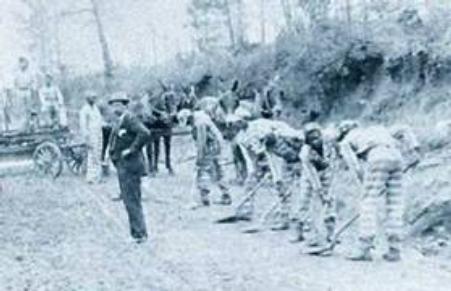When the Glendale - Cifton
Road was First Paved
Story furnished by Clarence Crocker
The Spartanburg County
Commission under the leadership of Mr. E. C. Burnett,
Chairman, announced through the Spartanburg Herald
on August 11, 1932 that steps preparatory to surfacing
the Glendale/Clifton road had been taken and that the
project would proceed as planned.
Surfacing of the 5.4
mile dirt road from Glendale to it’s intersection with
highway #8 (old Converse/Cowpens road?) via Clifton # 1
was expected to cost approximately $12,000. Money for
the project was to be advanced by the County board and
would be repaid by the proceeds of the gasoline tax.
Bids for furnishing the crushed stone were to be sought
at once, with work expected to begin very soon.
This writer remembers
the project well. The road ran directly in front of our
home, dividing some of our farm land. Being a county
road, the construction crew was primarily county
prisoners. Chain-gang camps where the prisoners stayed
were strategically located throughout the county. One
was located about a mile above our house on the
Glendale/Fernwood road at the intersection with the
Sloan Grove road. Another was located on Chain-Gang Hill
road just above Clifton #2 mill.
 Example of a chain gang but
not in Glendale.
Example of a chain gang but
not in Glendale.
Before they could surface the road it had to be
prepared with top soil. Using teams of horses and mules
with drag pans, wheel barrows, picks, shovels and rakes
they took top soil from our land as they did from most
all farms along the road in order to smooth the roadbed
for surfacing. Most days, traffic was maintained on the
road while the top soil work was being done. One day,
following a day of rain, a Pepsi truck came along and
got stuck in the soft clay. The prisoners got around the
truck, lifting and pushing and were able to get the
truck on the road again. Most every prisoner snatched
him a drink or two as the truck pulled away. The guard
seeing what happened, hollowed, stopping the driver but
when told what had happened, the driver thanked them and
asked if they all got one, if not “come get one” he
said.
After the soil had
been placed on the road bed, crude road graders (modern
at that time) smoothed and packed the roadbed. On the
day of surfacing traffic was detoured and trucks would
spread the gravel, which was smoothed by road graders,
with prisoners using shovels and rakes continuing to
smooth the gravel where needed.
After the road had
been smoothed, a truck spread boiling hot tar over the
gravel covered roadbed. A spur line had been built off
the electric trolley carline just
above our house in front of the old Sloan place on which
a tank of tar was sidetracked for use on the highway.
The tank was kept hot 24/7 until the tank was empty. A
truck spreading a fine gravel put a finishing surface on
the road.
Everyone up our way
was glad to see the road paved. With very few cars in
the neighborhood, not only did the mill workers walk
down a muddy road in the rain to work on rainy days
unless they rode the trolley, but all of us kids walked
about two miles a day to school and back. There were no
school buses for elementary school children at that
time. Fact of the matter, all village streets were dirt,
covered with cinders taken from the mill boilers. Folk,
believe this voice of experience when I say one doesn’t
know what the pain of a skinned knee really feels like
until they have fallen on a cinder covered road.
Today, the
Glendale/Clifton road is a State highway and is
maintained by the State Highway department. Since 1932,
it has been slightly modified and resurfaced many times.
The last time the road was modified was due to the
construction of the new Glendale Bridge. (Story of the
new bridge to be printed soon) The curve which carried
the roadway into the village flat and behind the Mill
Store onto the bridge was bypassed with a straight road
from the bottom of Highland Street across the bridge
into the Glendale/Whitestone road.
Incidentally, in 1932,
the Glendale/Clifton road which had been built to
replace the old Georgia road,
ran parallel with the Old Georgia Roadbed in front of
our house. Opened in 1805 as the “Federal Road Route”
which was later to be known as “The Old Georgia Road”
started in Savannah, Georgia running through the
Cherokee Indian Nation into and through South Carolina
into Tennessee. It was considered a major transport
route of that day.
The road had been
discontinued just beyond our house due to a large gully
on the Sloan property that was fast encroaching upon the
roadway. The gully had been caused largely by the runoff
of the roadway waters which were diverted when the new
road was built. The old Georgia road bed was then and is
today part of the drive way in front of four of the
Crocker family homes. The gully has been filled in with
highway and sidewalk debris generated from new road and
sidewalk construction in and around Spartanburg.


